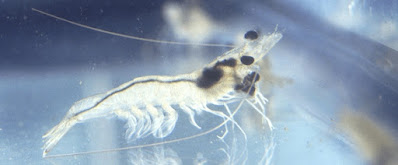How Shrimp See in the Deep Blue Sea
Anti-creationists are known for pseudo-intellectual posturing with dysteleology (claiming something was poorly design, so there is no God), but they use false comparisons. Clinton Richard Dawkins and others railed (out of his area of expertise) that the human eye as badly designed, and no amount of science and reason refuting such claims will be considered by their disciples. They even compare our eyes to those of critters and criticize the Master Engineer. Because atheism. Our eyes were designed for our environment, other eyes were designed for other environments. You savvy that, pilgrim?
 |
| Whiteleg shrimp image credit: NIH NLM (usage does not imply endorsement of site contents) |
The humble shrimp lives on the ocean bottom with very low light levels. But it can see very well. Now some Israeli scientists . . . have discovered the amazing fine tuning that enables shrimp to see in very low light.Decapod (10-legged) crustaceans, such as lobsters, shrimp, and crayfish have eyes quite unlike ours. Our eyes use lenses to focus light by refraction (bending), while decapods use mirrors to reflect light to a focus. . . . a marvel of intricate design, involving photonic crystals—nanostructures that can manipulate light at the wavelength level.
While this article has some technical aspects, I reckon that most people can get something out of it. To read the whole thing, see "Shrimp eye design — Reflective nanotechnology could inspire new optical coating."